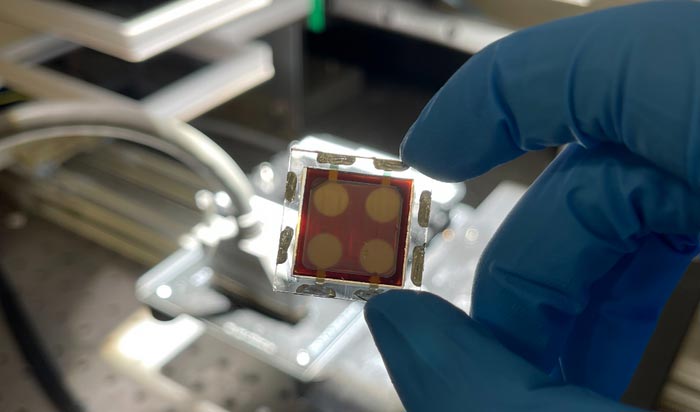Ammonium is the secret ingredient

A perovskite solar cell of the type used in this study
Credit: Exciton Science
… in stable, efficient & scalable perovskite solar cells.
Members of Exciton Science have created perovskite solar cells with 21% efficiency, the best results ever recorded for a device made from a non-halide lead source.
A new pathway to creating durable, efficient perovskite photovoltaics at industrial scale has been demonstrated through the first effective use of lead acetate as a precursor in making formamidinium-caesium perovskite solar cells.
Members of Exciton Science, based at Monash University, were able to create perovskite solar cells with 21% efficiency, the best results ever recorded for a device made from a non-halide lead source.
A mini prototype solar panel featuring these cells achieved 18.8% efficiency. The large-area perovskite layer was fabricated in ambient atmosphere and was made via a single-step blade coating, demonstrating its potential viability for industrial-scale manufacturing.
The test devices also showed strong thermal stability, continuing to function with no efficiency loss after 3,300 hours running at 65°C.
First author Jie Zhao, a PhD student at Monash University, said: “We’ve been able to use lead acetate in a one-step, spin-coating process to get the perfect, high-quality formamidinium-caesium perovskite thin film.
“And because we don’t need an anti-solvent agent, we can do this via large-scale techniques, such as blade coating, which means it’s viable at industrial scale.”
The results have been published in the journal Energy & Environmental Science and are available here.
Corresponding author and Monash University colleague Dr Wenxin Mao said: “The vast majority of perovskite solar cell research uses lead halides, particularly lead iodide.
“The lead iodide needs to be 99.99% pure and it’s very expensive to synthesise cells using lead iodide.
“We’re the first group to make highly stable formamidinium-cesium perovskite solar cells using lead acetate rather than lead iodide.
“We have provided the entire research community a second way to make high-quality perovskite solar cells.”
More about perovskites: Promise versus problems
Thin film solar cells made from perovskites have the potential to disrupt the solar energy sector, thanks to their relatively low manufacturing cost, flexibility and tunable band gap relative to silicon.
However, researchers are struggling to solve reliability issues, and they also need to find a way to create devices at a viable commercial scale.
Perovskites are solution processed (made in liquid) using a variety of different ingredients.
Most approaches use lead halides and require the inclusion of strong polar solvents with high boiling points and antisolvent quenching agents to control the perovskite crystallisation process.
This complicated mechanism can lead to defects in the thin films, which causes the resulting device to rapidly lose efficiency. It’s also hard to control.
The chemical compound lead acetate has emerged as a promising alternative precursor, because it can create ultrasmooth thin films with fewer defects.
Until now, lead acetate had only been used to make methylammonium or cesium-based perovskites, which are relatively unstable and not suitable for real-world applications.
A better candidate for commercial use can be found in perovskites made using formamidinium and caesium, thanks to their superior stability. Previous attempts to synthesise them using lead acetate as the precursor failed.
To investigate and solve this issue, the researchers, together with their collaborators at Wuhan University of Technology in China, examined the underlying molecular mechanisms.
Through X-ray diffraction and nuclear magnetic resonance spectroscopy, they identified the need to use ammonium as a volatile cation (positively charged ion) at a critical stage.
Contributing author Dr Sebastian Fürer said: “The presence of ammonium served to drive away the residual acetate during annealing, without forming unwanted side products.”
The researchers hope their work on the fundamental chemistry governing precursor behaviour can encourage a greater focus on scalable synthesis and fabrication methods of metal halide perovskite devices.
Journal: Energy & Environmental Science
DOI: 10.1039/d2ee01634f
Method of Research: Experimental study
Subject of Research: Not applicable
Article Title: Efficient and stable formamidinium–caesium perovskite solar cells and modules from lead acetate-based precursors
Article Publication Date: 1-Dec-2022
COI Statement: There are no conflicts of interest to declare.
All latest news from the category: Power and Electrical Engineering
This topic covers issues related to energy generation, conversion, transportation and consumption and how the industry is addressing the challenge of energy efficiency in general.
innovations-report provides in-depth and informative reports and articles on subjects ranging from wind energy, fuel cell technology, solar energy, geothermal energy, petroleum, gas, nuclear engineering, alternative energy and energy efficiency to fusion, hydrogen and superconductor technologies.
Newest articles

Innovative 3D printed scaffolds offer new hope for bone healing
Researchers at the Institute for Bioengineering of Catalonia have developed novel 3D printed PLA-CaP scaffolds that promote blood vessel formation, ensuring better healing and regeneration of bone tissue. Bone is…

The surprising role of gut infection in Alzheimer’s disease
ASU- and Banner Alzheimer’s Institute-led study implicates link between a common virus and the disease, which travels from the gut to the brain and may be a target for antiviral…

Molecular gardening: New enzymes discovered for protein modification pruning
How deubiquitinases USP53 and USP54 cleave long polyubiquitin chains and how the former is linked to liver disease in children. Deubiquitinases (DUBs) are enzymes used by cells to trim protein…



